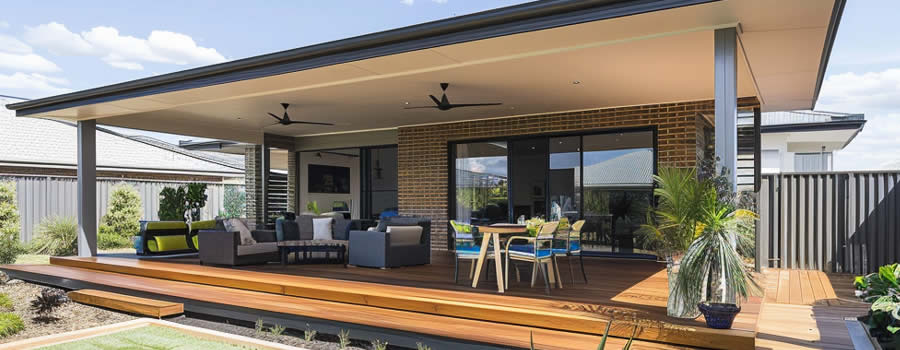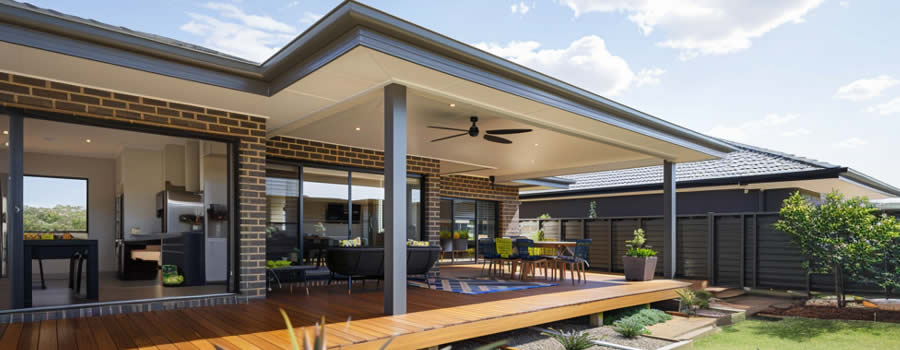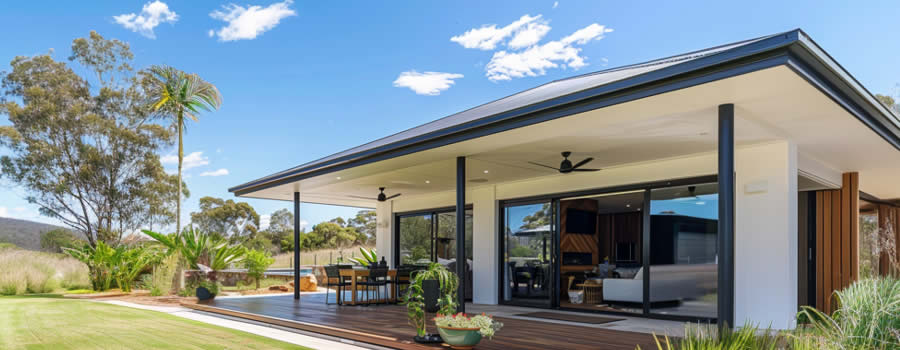How Much Does a Patio Cost?
Key Factors That Impact Patio Pricing
Outdoor patios create an inviting place to relax, dine, entertain, and enjoy.
Typical costs to install a new patio range widely, from $2,000 for a very basic 10′ x 10′ slab up to over $15,000 for a high-end custom patio with premium features.
This comprehensive article will cover the main factors that affect pricing, so you can set realistic expectations when planning a patio project.
Average Patio Installation Costs
Total cost averages for installing a new or replacement patio are:
- Small (9-19 square metres) – $2,000 to $4,000
- Medium (19-37 square metres) – $4,000 to $10,000
- Large (Over 37 square metres) – $10,000 to $15,000+
The overall price depends largely on:
- Square meterage (more space equals higher budget)
- Type of materials used (basic concrete vs. premium paving, stone or tile)
- Site preparation work needed
- Additional features beyond basic structure
Cost Per Square Metre
Patio estimates usually break down pricing per square metre of finished area. This allows easy comparison across materials and patio design options. Average cost per square metre ranges:
Surface Materials
- Concrete- $86-108
- Pavers- $108-162
- Natural stone- $162-323
- Ceramic/porcelain tile- $162-215
- Timber decking- $162-269
- Composite decking- $215-323
The overall cost per square meter factors in the labor, equipment and time needed for proper installation based on the surface material. Naturally porous materials like travertine require extra excavation and base layers to prevent sinking or cracking compared to concrete pavers. Composite or hardwood decking have elevated substructures for stability and drainage underneath.
Key Factors That Increase Costs
Beyond the base price per square meter for the decking material, many additional elements contribute to the total project budget. Especially as home owners look to build out larger patios with extra amenities, these upgrades add up quickly.
Size – Bigger is Pricier
The overall square meterage determines how much material is required. A basic 3.6m x 3.6m pad requires 13 sq. m. while an expansive 9m x 9m area needs 81 square meters, over 6 times more materials! Economies of scale also apply to the preparation work needed underneath based on the footprint.
Premium Materials
Concrete slab provides an affordable, neutral base. However, many homeowners opt for more upscale finishes like decorative pavers, textured natural stone, or ceramic tile. These are offer wider style options but cost more in initial purchase and specialised installation. Hand-laid stone runs $269-538 per sq. m just in labor before the stone cost.
Foundation Requirements
The subsurface foundation constitutes a major portion of patio construction budgets, averaging $32-86 per sq. m. This prep work includes:
- Excavating and grading soil
- Compacting layers of gravel and sand to stabilise
- Pouring concrete footings around perimeter
- Installing tie beams for structural reinforcement
Skimping on the subsurface preparation leads to shifting, sinking and cracking in patio materials down the line.
Please let me know if you need any other changes to correctly convert square feet to square meters while preserving the full detail.
Roofing Structures and Shades
While open-air designs remain popular, patio covers extend usage during rainy weather conditions. Attached solid patio roofs cost around $269-538 per sq. m including supporting posts, beams and roofing materials. Freestanding structures like pergolas run $1,500-2,500 depending on size, wood type and attachments to the home. Retractable shade cloth systems average over $8,000 per 10 square meters.
Railings and Safety Codes
Patios elevated 60+ cm above ground level require railings by safety code. Cable, glass panel or metal balustrade railings often add decorative flair but boost costs $538-1,075 per linear meter installed based on material and height required.
Lighting Elements
Lighting allows patio floor to remain usable into the night for dining, lounging or entertaining. Ambient ground and hanging lots of lights cost approximately $1,075 per fixture. Hardwired low voltage systems with switches and controls run $2,500+.
Enclosure
Fully or partially enclosing your dream patio with added screens, windows, or insulation will raise costs but may allow for expanded use in colder months.
Furnishings
Chaises, dining sets, umbrellas, and fire tables equip the patio for full function. Mid-range seating and tables cost $2,000-4,000. Weather-resistant fabric, woods and metals withstand the elements.
Special Features
Homeowners often incorporate amenities like fireplaces, hot tubs, outdoor kitchens or sound systems. Fire pits start around $1,200. Complete outdoor space with cabinetry, appliances and granite countertops average $15,000+. These features enhance ambiance and usability but require connections to utilities and boost long-term care.
Installation Process and Considerations
The installation process entails careful planning and phased construction for sound structures. Key steps include:
a. Demolition and Removal
Existing patios or landscaping first get removed through jackhammering concrete or excavating plantings. Dumpsters hold debris for disposal.
b. Site Layout and Measurements
Contractors measure the site and use string lines to layout the patio shape and dimensions accurate to 1⁄4 inch.
c. Excavation and Grading
Earthmovers dig down roughly 12-18 inches removing soil to reach stable layers for the subsurface layers. The area gets leveled and compacted.
d. Gravel and Base Layer
4-6 inches of gravel packs down to form the base, topped by 2 inches of sand. These porous layers prevent frost heaving and stabilise materials.
e. Perimeter Foundation
Concrete beams 12-24 inches wide pour around patio edges to reinforce structure. Tie beams often run perpendicular across the middle underneath.
f. Surface Material Installation
The chosen finishing layer like stone, tile or pavers lays atop the stabilised base and attaches to foundation edges. Gaps fill with sand or gravel.
g. Finishing Touches
Grout fills gaps in tile or stone layouts. Sealants protect surfaces. Railings mount to framework secured in footing below frost lines. Light fixtures and furnishings install last.
DIY or Hire Out?
Homeowners good at demolition and building can do parts like digging and ground work to save money. But hire pros as needed for:
- Electrical wiring, plumbing, gas (for fireplaces)
- Fancy stone or paver designs
- Get quotes from a few companies.
Either way, good base work is key so the patio lasts. Rushed jobs sink or crack later. Make sure the ground won’t shift under materials.
Also check what building permits are needed for the work.
Tips for Cost-Saving Patios
Residents with limited budgets can still achieve lovely patios. Choices for keeping project costs down include:
1. Build smaller footprints
Size just big enough for intended uses. Small patios still feel welcoming with cozy furniture arranged well.
2. Choose basic concrete or pavers
Skip expensive stone, tile or deck choices. Stain concrete for colour if desired. Add accent stone planter boxes.
3. Start with a pergola then add roofing
Open structures cost less initially but still support climbers for lushness. Add retractable shades later as budget allows.
4. Purchase furnishings over time
Focus installation dollars on durable foundation and surface materials first. Then incrementally buy seating, lighting and decor.
5. Do excavation, demolition and site work yourself
DIY labor cuts costs even if hiring for technical structural portions. Follow safety best practices.
6. Construct in phases
Break the project into pieces completed over years as possible. Perhaps start with a stone dining section then add a lounge area later.
Balancing wants, needs and budget means considering which pieces bring the most day-to-day quality of life enhancement before pricing everything wish-listed. Even modest patios extend living areas to the outside.
Long-Term Cost Considerations
While building the patio itself marks a major investment, dwellers should also factor ongoing care into long-term budgets to maximise durability and enjoyment. Typical yearly costs range:
Maintenance Services
Sealing coloured concrete patio, power washing wood, replacing damaged tile or stone, spraying deck stains. Allow $200-600 depending on size.
Winterisation
Removing outdoor furniture to storage, shutting off water lines to kitchens/hot tubs. Snow removal costs extra if not DIY.
Furnishings Upkeep
Replacing faded fabric or broken components on seating sets or shade structures. Repair lighting fixtures.
Safety Inspections
Check railings, steps, foundations for any shifting or faults requiring repair every 2-3 years.
Permit Renewals
Some permanent structures need inspection/renewal every 3-5 years. Fees based on location.
Properly maintaining patio foundation integrity avoids costly reconstruction down the road. Sealants protect surfaces from weathering damage and keep materials clear of debris. Patio furniture wears better when removed from elements during winter in northern climates. Repair minor issues quickly before they compound structural problems.
Enjoy Your New Outdoor Living Space!
Installing a patio greatly enhances quality living by expanding entertainment area and connecting property owners to the outdoors.
This guide covered key considerations for planning a project to meet needs and budget based on size, materials, features and long-term upkeep.
Patios provide lasting returns as upgrades that increase home resale values anywhere from 8-15% compared to indoor remodels. Turning a basic yard into a welcoming sanctuary for relaxation or social gatherings pays dividends for years to come.
Pro Tip:
Be sure to get multiple quotes from qualified patio builders to compare pricing. Estimates from different patio flooring cost providers can vary widely. Checking multiple patio prices will help you find the best value.



